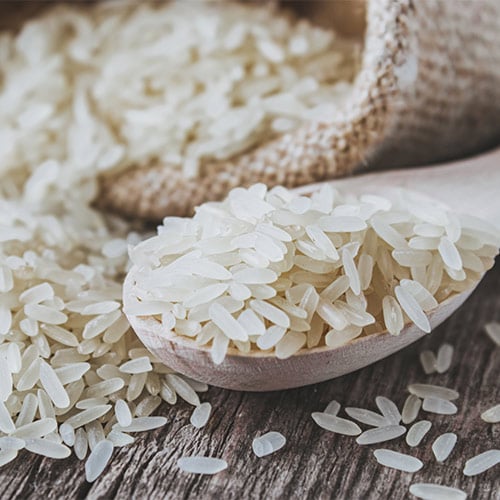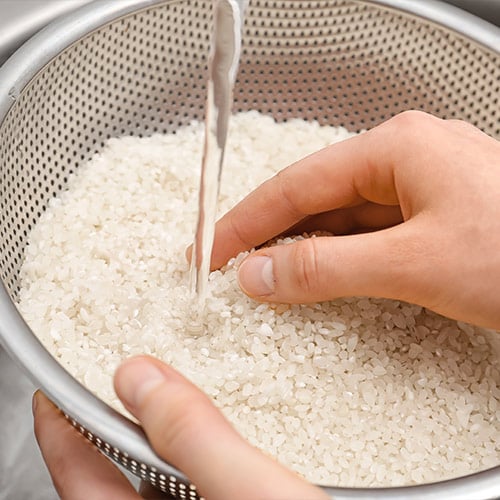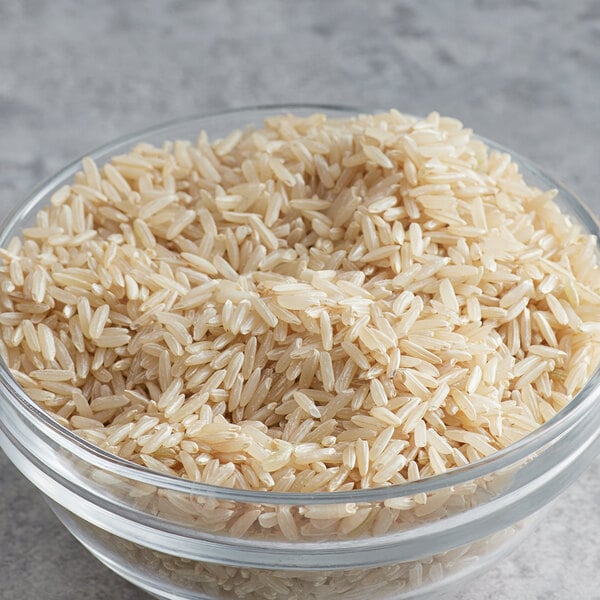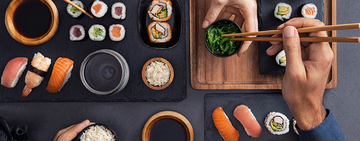Do you rinse your white rice every single time? If the answer is no, you aren’t alone. When you have a long list of kitchen prep work, rinsing rice tends to be a lower priority. So, is rinsing rice necessary? It turns out that the answer to this question isn’t so cut and dry. There are some very good reasons to rinse rice, but it won’t ruin the dish if you don’t. We’ll explain the benefits of rinsing your rice before adding it to a rice cooker and provide you with two easy rinsing methods.
Shop All Bulk RiceHow to Rinse Rice
Rinsing rice is very simple, but there is a technique that will make your life easier. Watch our video to see two methods in action:
Why Should You Rinse Rice?

It seems like an extra step, but there are some important reasons to rinse rice grains before cooking. Learn more about the benefits of a simple rinse below:
1. Hygiene
First off, cleaning rice rinses away impurities and pesticides. Is the packaged rice you buy that dirty? No, probably not. Rice manufacturers in the US use a process that removes most impurities. But if you buy rice from a bulk bin, or you live in a part of the world where rice is sold in burlap bags, then your rice probably does contain some level of dirt and debris. Some experts recommend rinsing rice to reduce contaminants from polluted groundwater.
2. Texture
The second reason to rinse rice is that it improves the texture of your cooked product. Water rinses away free starch from the surface of the rice, which keeps the grains from sticking together in a mushy clump. Free starch is a powdery residue left behind from the milling process of white rice. If you don’t rinse it away, the starch creates a gluey film as the rice cooks. Rinse away the extra starch and the rice will be sticky enough to fluff up, but not too gummy. If you’ve been having trouble achieving the “just right” texture with your rice, try adding the rinsing step to your prep.
3. Flavor
Another component of the rinsing rice dilemma involves the presence of oils on the rice grains. The milling process of white rice doesn’t just leave behind starch, it also leaves behind lipids. These lipids naturally occur in the rice bran, but they can cause the taste and smell of rice to become stale. The presence of lipids on white rice is very small, but as these oils are exposed to air, they become pungent. This is the reason that rice may have an “off” smell to it. Rinse the rice to remove the lipids and improve the taste of the cooked product.
4. Culture
In many Asian cultures, rinsing rice is just a fact of life. If you're cooking rice to pair with an Asian sauce, skipping this step and you’ve made a huge blunder. Part of this is a holdover tradition because rice wasn’t always as clean as it is today. In the past, rice may have been stored in a burlap sack or even in a barn. Rinsing it clean was necessary because the rice was exposed to dust, debris, and insects.
Also consider that Asian cultures have been consuming rice for centuries, and the cooking process has been perfected over time. In Japanese cooking, for example, it’s normal to rinse the rice several times until the water runs clear to achieve the very best texture.
When Should You Skip Rinsing Rice?
You should skip rinsing rice if you are making risotto, paella, or rice and beans. In these instances, the free starch present in the rice contributes to the creamy texture of these dishes. The same goes for gumbo and jambalaya.
You also don’t need to wash brown rice because the bran and hull have not been milled away. There is no free starch present on types of rice that still contains the bran. Or, if you simply like the texture of extremely sticky rice, don’t rinse it!
Rice Rinsing Methods
When it comes to rinsing rice for commercial purposes, several methods can be used to ensure the grains are clean and ready for cooking. Each method has benefits and is suitable for different types of rice. Here are the two most common rice rinsing methods:
Sieve Rice Rinsing Method

A sieve is a useful kitchen tool to keep on hand, so if you don’t have one already, it’s time to make a small investment. Make sure to use a sieve, not a colander. Rice grains will slip right through the large holes of a colander.
- Add the desired quantity of uncooked rice to a fine-mesh strainer or sieve.
- Hold strainer beneath a running faucet using cold water.
- Rinse for 30 seconds to 1 minute, or until water runs clear.
- Shake rice gently to drain any remaining water, then add to the rice cooker.
Bowl Rice Rinsing Method
The bowl rice rinsing method takes longer but removes more starch from the rice. You'll need a large mixing bowl and a fine-mesh strainer.
- Add desired quantity of rice to a large bowl and cover with cold water.
- Swirl rice with your hand until water becomes cloudy.
- Carefully pour out water and refill with clean water.
- Swirl rice a second time and use a fine-mesh strainer to drain all water from the rice.
- If desired, repeat until water is clear.
Rice Rinsing FAQ

We answer some common questions about rinsing rice below:
Do You Need to Rinse Until the Water Is Clear?
Rinsing white rice until the water runs clear ensures that all free starch is removed. It’s not 100% necessary in all applications, but it does help improve the texture. We recommend rinsing until the water is clear if you serve many rice dishes on your menu or if you find that your rice is too gummy.
Do You Need to Rinse Brown Rice?
No, brown rice is processed differently than white rice and does not require a rinse. It still contains the protective bran covering, and no free starches or lipids will be present on the surface.
Should You Rinse Rice for Risotto?
No, you shouldn’t rinse rice before making risotto. The starches present will improve the texture of your dish.
Can You Rinse Sticky Sushi Rice?
Yes, it’s okay to rinse sticky rice and it’s often recommended by chefs. The rinsing process will not ruin the sticky texture that's needed to create sushi rolls.
Does Rinsing Rice Make It Sticky?
Rinsing rice will not make it sticky. In fact, rinsing white rice before cooking can make it less sticky. When rice is harvested and processed, it can accumulate excess starch on the surface of the grains. This excess starch is what causes rice to become sticky when cooked. By rinsing the rice before cooking, you can remove some of this surface starch, resulting in grains that are less likely to stick together during the cooking process.
White rice may seem like a plain dish, but when it doesn’t have the right texture, a rice lover will know! If you serve large quantities of rice at your restaurant, it could be beneficial to try out some rinsing methods. Find out what works for you and incorporate it into your daily prep.



